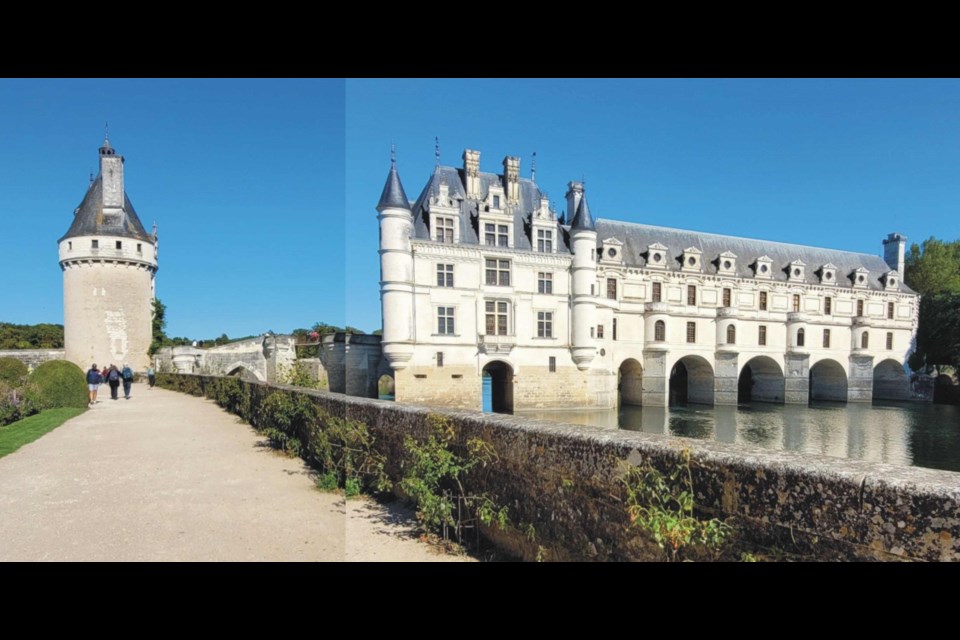After our sojourn in Normandy, we headed south to visit a few castles and gardens in the Loire Valley. Perhaps the most impressive of those visited was Villandry, an estate whose current buildings date back to 1536. The traditional gardens were converted to an English-style park in the 1700s but were restored to their original splendour by Joachim Carvallo, a Spaniard who bought the estate in 1906. Joachim left his scientific career to devote his time exclusively to his property.
The gardens were lovingly restored over 10 years from 1908 to 1918. As a scientist, Joachim researched gardening techniques and vegetable growing, excavated part of the property to unearth archaeological details such as wall foundations and piping and spent endless hours poring over existing maps of the property. The six-hectare (14-acre) gardens have been open to visitors since 1920 and depend on tourism for upkeep. The property is currently owned by Joachim's great-grandson, Henri Carvallo.
Because of the predominant use of boxwood hedges and annual flowers and vegetables, the upkeep of the gardens is pretty labour-intensive and employs nine full-time gardeners and two apprentices. Since 2009 they have become completely organic, eliminating chemical insecticides from the garden. There are over one thousand lime trees (linden or Tillia) on the property that from 1990 onwards were systematically sprayed for the red spider mite Eotetranychus tiliarum, which caused discolouration of the leaves and early leaf fall. Villandry worked with the University in Tours to come up with a solution and now has introduced predatory mites to keep the red spider mites under control. Irrigation is automatic and controlled by computer. Regular hand hoeing of the flower beds controls weeds and improves water absorption.
The property was a pleasure to visit both inside and out. The garden has been brought inside with beautiful flower arrangements, paintings of flowers, botanical drawings of vegetables, wrought iron floral designs on the railings of staircases and the large windows which give you great views of different parts of the garden. Visitors also have the option of climbing to the top of the keep for an overview of the entire garden and property, definitely a worthwhile destination for garden lovers.
The next property, Chenonceau, appealed to me, not because of its gardens, although these were extensive, but more because of its remarkable location on and across the Cher River and its history as the Ladies Castle.
Between 1513 and 1521, Thomas Bohier (then Finance Minister) and his wife Katherine Briçonnet demolished the fortified castle and mill on the property except for the keep or Marques Tower which they restored in Renaissance style. Katherine (the First Lady) was the true developer of the castle and the property around it.
In 1547, King Henry II donated Chenonceau to Diane de Poitiers. She extended the castle across the Cher river and developed the area now known as Diane's garden.
Catherine de Medici, Henry II’s widow, removed Diane from the castle. She added what today is known as Catherine's garden and raised the height of the two-floored gallery across the Cher, so she could throw glorious parties.
Louise of Lorraine moved into the castle in 1589 upon the death of Henry III. Her death in 1601 marked the end of the royal presence at Chenonceau. But not the end of influential women.
In 1733 Louise Dupin held court or had salons or gatherings in Paris as well as at Chenonceau. She was a writer and invited writers, poets, scientists and philosophers, among them Voltaire, and Rousseau. She is credited with saving the Chateau during the French Revolution.
In 1864 Marguerite Pelouze, a descendent of the Industrial Bourgeoisie spent a fortune on the estate to return it to the splendor of Diane de Poitiers’ era. In 1913, the castle was sold to the Menier family. During the First World War, the first and second galleries were transformed into a hospital. Up until 1918, over 2000 patients were cared for by Simonne Menier, the matron of the family and the hospital. The hospital was financed by the Menier family whose claim to fame in France was a chocolate factory until 1965.
From 1940 to 1942 the castle served as an escape route for refugees from Germany. The North side of the river was German-occupied, while the South side was Vichy-controlled.
After a significant flood in the area, the castle sat abandoned for some time until the Menier family decided to restore both the castle and the grounds to its former glory. Chenonceau is the second most visited castle in France after Versailles.
The gardens include Diane's garden, Catherine's garden, a vegetable and flower garden, a maze as well as the Green Garden and Russel Page Garden. So, plenty to see and learn for both the gardener and the history buff.
This column is provided courtesy of the Saskatchewan Perennial Society (SPS; [email protected]). Check our website (www.saskperennial.ca) or Facebook page (www.facebook.com/saskperennial) for a list of upcoming gardening events.




